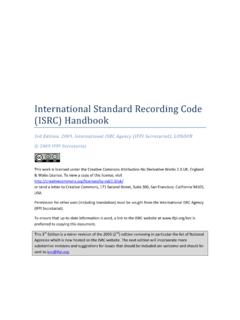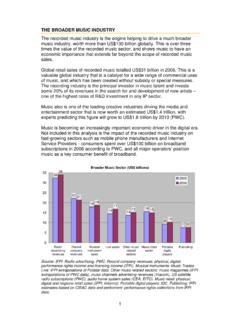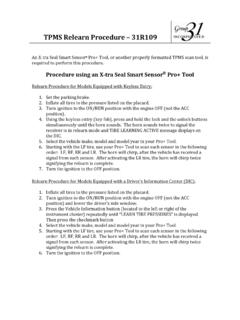Transcription of The WIPO Treaties: Technological Measures - IFPI
1 EXECUTIVE SUMMARY Technological solutions them-selves are not invulnerable. Technical systems can be hacked. Unauthorised pass-words and access codes frus-trate access-control software. And the making and distribu-tion of circumventing devices pose a serious danger to the integrity of any TPM. As no Technological measure can permanently resist deliber-ate attacks, a TPM is only as good as its legal protection. Protecting TPMs is important both for rights owners and con-sumers. Of course, TPMs de-ter piracy, and encourage rights owners to use new media like the internet. But by allowing a wide range of listening, copying and trans-mission options, TPMs also permit the development of new marketing, distribution and usage models, which open up a sophisticated new range of ways of enjoying music. Consumers will benefit from these new ways of enjoying music and other copyrighted products, but only if TPMs are meaningfully protected. TPM protection also benefits telecommunications and equip-ment providers.
2 Internet ser-vices profit from increased traf-fic and legitimate electronic commerce in copyrighted ma-terial. And consumer electronics and computer producers, which spend substantial sums devel-oping new equipment and en-cryption technologies to play protected material, find their innovation frustrated and their investment rendered worthless if TPMs can be neutralised by hacking. WHAT ARE Technological Measures ? the wipo treaties : Technological Measures WHY IS IT IMPORTANT TO PROTECT TPMS? With the introduction of legal protection for Technological Measures , the wipo treaties create a unique new way of protecting copyrighted prod-ucts as new digital and inter-net-based uses emerge. The treaties recognise that au-thors and other rights owners increasingly rely on technical means commonly known as Technological protection meas-ures or TPMs such as en-cryption and other mecha-nisms to control unauthorised copying, transmission and use of their products. TPMs take various forms and their features are continually changing, but some major fea-tures remain constant.
3 The most basic and most important kind of TPM is access control technology. One common way of controlling access is encrypting or scrambling the content. In such case the user gets the data but must follow an additional procedure to make it usable. Another form of access control is a procedure that allows ac-cess to a source only with proof of authorisation, for ex-ample, password protection for a computer server. The other major type of TPM, copy or use controls, enable the rights owner to allow certain permitted activities but to pre-vent illicit activities by a user who has access to the work. The wipo Copyright Treaty (WCT) and the wipo Per-formances and Phonograms Treaty (WPPT) require ade-quate legal protection and ef-fective legal remedies against the circumvention of TPMs applied to protected works and phonograms. (WCT Art. 11; WPPT Art. 18.) These provisions are formu-lated in a broad and neutral way, oriented more to the de-sired result than on how to achieve it.
4 In implementing these treaty provisions, how-ever, governments have recog-nised that their laws need to cover the act of circumvention itself, as well as the manufac-ture and distribution of a range of circumvention devices, in or-der to provide adequate and effective protection. Technological protection Measures (TPMs) deter pi-racy, encourage rights own-ers to use new media like the internet, and provide con-sumers a sophisticated new range of ways of enjoying music. the wipo treaties require effective legal protection of TPMs. Governments have recognised that this means protecting against hacking and covering a range of cir-cumvention devices and re-lated illicit activities. wipo treaties : Technological Protections March 2003 HOW SHOULD THIS BE IMPLEMENTED? Page 2 Most countries are finding that their copyright laws require some modernising to deal with TPM protection adequately. There are several elements that governments and rights owners have found crucial to effective legal protection for TPMs: nProtection of access and copy control technologies.
5 The treaties require protection of TPMs (1) that are used in connection with the exercise of rights, and (2) that restrict unauthorised acts. This only covers TPMs applied to works protected by copyright or related rights. Clearly this protection should apply to copy and use control TPMs that directly restrict un-authorised reproduction, public communication, or other direct exercises of the rights owner s rights. Protection likewise should ap-ply to access-control technolo-gies, which also meet both tests of the treaties . Rights owners use access control, presently the most popular type of TPM, in connection with the exercise of their rights whether selling physical copies or disseminating electronic copies to the public. Access controls not only pre-vent unauthorised use but also discourage unauthorised repro-duction, distribution and trans-mission. n Protection against act of circum-vention. The treaties explicitly require legal protection and ef-fective remedies against the act of circumvention of TPMs.
6 Circumvention is sometimes called hacking manipulating the Technological measure in some way so as to limit or eliminate the function it was designed to perform. The US law implementing the treaties defined circumvention as avoiding, bypassing, removing, deactivating, or otherwise im-pairing a Technological meas-ure. n Prohibition of circumventing devices. Adequate legal protec-tion and effective legal remedies cannot stop at prohibiting cir-cumvention itself. In order to control widespread hacking and other circumventing activities, circumvention devices and other means designed to facili-tate hacking also must be con-trolled. This does not require outlawing multi-purpose devices like per-sonal computers as such, simply because they can be used for a range of illicit purposes. Gov-ernments have recognised that devices must be controlled, however, if they are designed or adapted to circumvent. This formulation has been re-fined in EU legislation and else-where to include devices that (1) are primarily designed or pro-duced for the purpose of circum-vention, (2) have only a limited commercially significant purpose or use other than to circumvent; or (3) are marketed, promoted or advertised for circumvention purposes.
7 NDevices, components and other means. Circumvention devices are not always an isolated black box , such as a pirate de-coder. They can also be one part of a more complex piece of equipment, or an intangible means such as computer soft-ware or access codes, that has the same function as a stand-alone circumvention device. It is thus important that rules on circumvention devices apply equally to parts and components of devices, software, algorithms and access information such as passwords and access codes that otherwise meet the definition of an illicit device. nManufacture, distribution, offer-ing to the public, communication of devices and services. A range of activities related to circumven-tion devices should be covered. In most cases, treaty imple-menting legislation has ex-tended to all manner of manu-facture, marketing, offering to the public and distribution of circumvention devices, as well as services that assist with such circumvention. Not only are the features of TPMs and devices subject to continuous change, but the catalogue of activities that pro-mote circumvention of TPMs also will change over time requiring a broad definition of the acts covered by legislation dealing with circumvention de-vices and services.
8 N Effective remedies. The trea-ties also explicitly call for effec-tive legal remedies. This is of great importance, because ac-tion against hacking and other circumvention of TPMs must be sufficiently speedy, efficient and deterrent to counteract the otherwise great incentive hack-ers and pirates have to break TPMs and steal content. Effective legal remedies should include both criminal law sanc-tions and civil law remedies. Criminal penalties should per-mit fines and prison terms in appropriate cases. To serve as a deterrent, civil law should allow fast and efficient preliminary proceedings, in-junctive relief, payment of dam-ages including statutory dam-ages, and the obligation to co-operate in neutralising harm already caused. To get illicit devices out of cir-culation, remedies also should allow tracing, seizure, retention and destruction of physical de-vices and intangible software and information. Criminal penalties and civil remedies should not be any lower than those available for copyright infringement.
9 wipo treaties : Technological Protections wipo TREATY TEXT WCT Art. 11. Contracting Parties shall provide adequate legal protection and effective legal remedies against the circumvention of effective Technological Measures that are used by authors in connection with the exercise of their rights under this Treaty or the Berne Convention and that restrict acts, in respect of their works, which are not authorised by the authors concerned or permitted by law. WPPT Art. 18. Contracting Parties shall provide adequate legal protection and effective legal remedies against the circumvention of effective Technological Measures that are used by performers or producers of phonograms in connection with the exercise of their rights under this Treaty and that restrict acts, in respect of their performances or phonograms, which are not authorised by the performers or the producers of phonograms concerned or permitted by law. IFPI Model Legislation (Option 1): It shall be unlawful to circumvent any Technological protection measure applied to a work or phonogram; or to manufacture, offer to the public, distribute or in any other way traffic in devices, components, services or other means designed, adapted or pro-moted to circumvent such a measure .
10 The civil and criminal procedures, remedies and sanctions applicable to copyright infringement shall apply to any violation of this provision. IFPI Model Legislation (Option 2): (a)It shall be unlawful to circumvent any Technological measure that is applied to a work, phono-gram or other protected material and that is designed to prevent or restrict, in the normal course of its operation, access to the material or acts that are not authorised by the rights owner. Circumvent shall mean avoid, bypass, remove, deactivate or otherwise impair. (b)It shall be unlawful to manufacture, import, distribute, sell, rent, possess for commercial pur-poses, offer to the public, advertise, communicate or otherwise provide any device, part, compo-nent, technology, service or other means that (1)is primarily designed, produced, adapted or performed for the purpose of circumventing, (2)has only a limited other commercially significant purpose or use other than to circumvent, or (3)is marketed, promoted or advertised for the purpose of circumventing any such Technological measure .












